
 |
Eager Space | Videos by Alpha | Videos by Date | All Video Text | Support | Community | About |
|---|


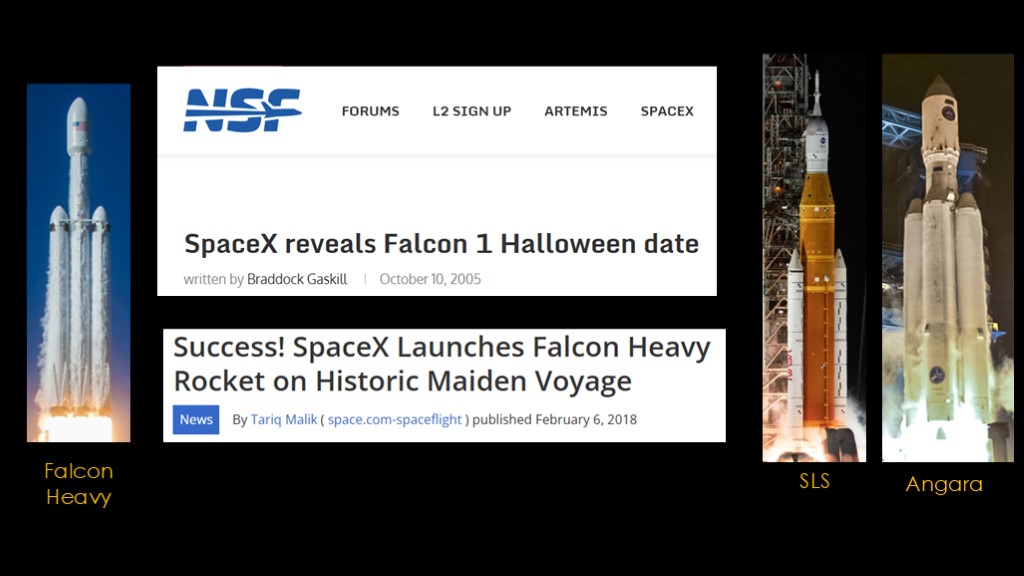
The first mention of the three booster "Falcon 9 Heavy" rocket comes way back in in October of 2005. Those of you who know SpaceX history might note that this was 5 months before the first successful flight of Falcon 1, so it was a long time ago.
It was over 12 years later that Falcon Heavy would first fly, pretty much tying NASA's SLS rocket for the winner of "longest rocket development time in the US". They are both soundly beaten by the Soviet Angara, conceived in 1992 and not flying until 2014, a 22 year long development.
The long development time of Falcon Heavy seems out of place given SpaceX's "move fast" philosophy, and it's sometimes been used by detractors as an example of a SpaceX failure.
The reality is actually quite a bit more interesting. We'll need to go back to 2010...
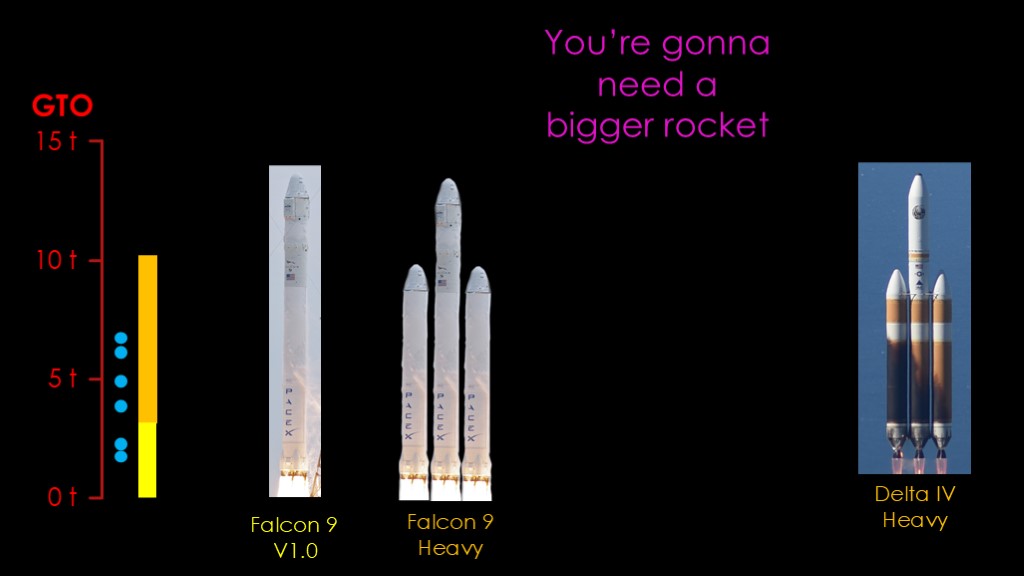
The year is 2010 and SpaceX has a problem. They have a contract to develop Falcon 9 for the NASA commercial resupply program, but that was only one market and they need more launches to make the Falcon 9 a success.
SpaceX wants to enter the lucrative market of geosynchronous satellite launch, but the payload capacity of Falcon 9 V1.0 for those launches to geosynchronous transfer orbit - or GTO - was a disappointing 3.4 tons. If we look at the communications satellite payloads that were launched by Ariane 5 in 2010, we see that only 2 of them could fly on Falcon 9, and that would leave no margin for first stage reuse. And those satellites were getting bigger over time.
The fix was clear. You're gonna need a bigger rocket.
When McDonnell Douglass was designing the Delta IV, they had the same problem, and they came up with the Delta IV Heavy, which roughly tripled the GTO payload of the rocket. That's why SpaceX announced the rocket they called Falcon 9 Heavy; it gave a much higher GTO payload, one which would cover all the current satellite sizes. It's a cool idea but is a significant engineering challenge.
Falcon 9 Heavy was actually plan B for a bigger rocket, and we'll need to spend some time looking at how plan A turned out...
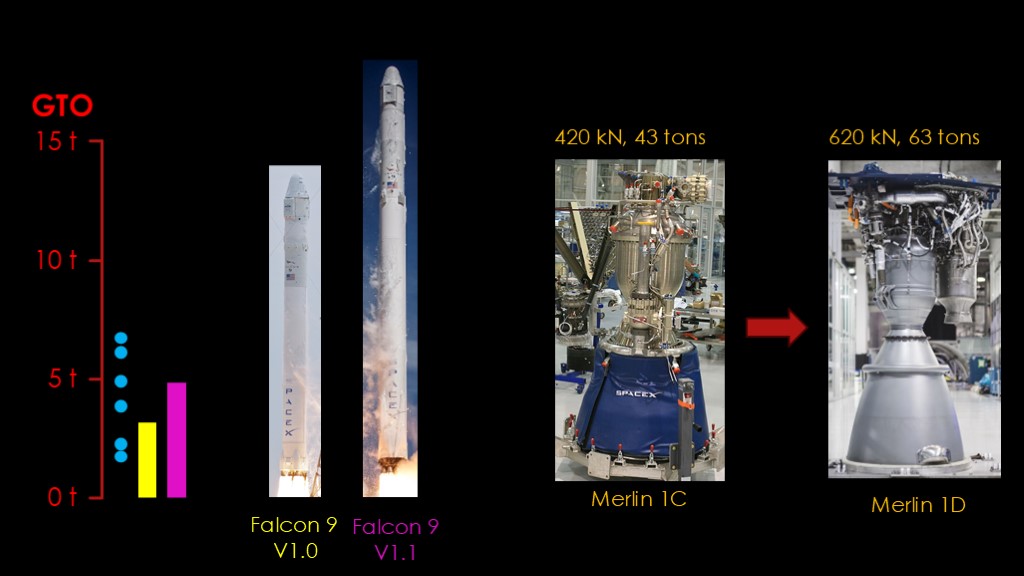
Falcon 9 Version 1.0 used the Merlin 1C engine, a version that first flew on Falcon 1. SpaceX used it because it was the quickest way to get Falcon 9 up and flying and they needed to start flying cargo flights as soon as possible. The Merlin 1C was moderate in terms of efficiency but it was nice and light, with a thrust to weight ratio about 90, more than pretty much any engine burning RP-1 kerosene and liquid oxygen. It generated 420 kilonewtons of thrust or about 43 tons.
But the Merlin team wasn't finished, and they soon coughed up a new version, the Merlin 1D. It pushed the thrust up to 620 kilonewtons, or 63 tons, pretty much a 50% increase. More thrust means you can lift a bigger rocket, and the Falcon 9 version 1.1 was 40% taller and 50% heavier. That upsize pushed the GTO payload up to 4.9 tons, an increase that actually made it reasonable for SpaceX to start flying some of the smaller geosynchronous communications satellites and to start working seriously on reuse.
This new rocket covered more of the target market and made Falcon Heavy less critical from a business perspective. It was a big investment in time and engineering resources to build Falcon Heavy.
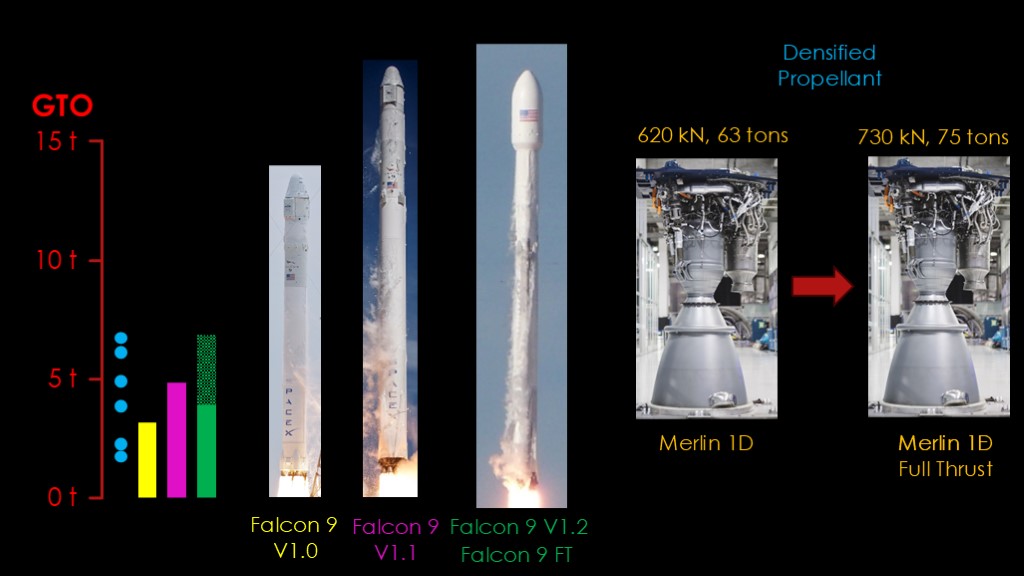
The Merlin team still wasn't finished. Their next version was naturally called Merlin 1E.
Just kidding. The SpaceX team seems to delight in breaking naming conventions on a whim, so this version was Merlin 1D full thrust, raising the takeoff thrust by another 17%. But now they had a bit of a problem. Falcon 9 couldn't get any wider and still travel by truck and it was already very tall and thin, so they didn't want to make it taller.
So they adopted a trick that had been researched in the past known as densified propellant or sub chilling. If you cool the propellants down below their usual temperatures, they become denser and you can therefore fit more into a given volume, about 8% more in this case.
The rocket is sometimes known as Falcon 9 V1.2 but is more commonly known as "full thrust". It can carry 3.9 tons to geosynchronous transfer orbit with first stage reuse and a full 6.8 tons in expendable mode. That covers *almost* all the market.
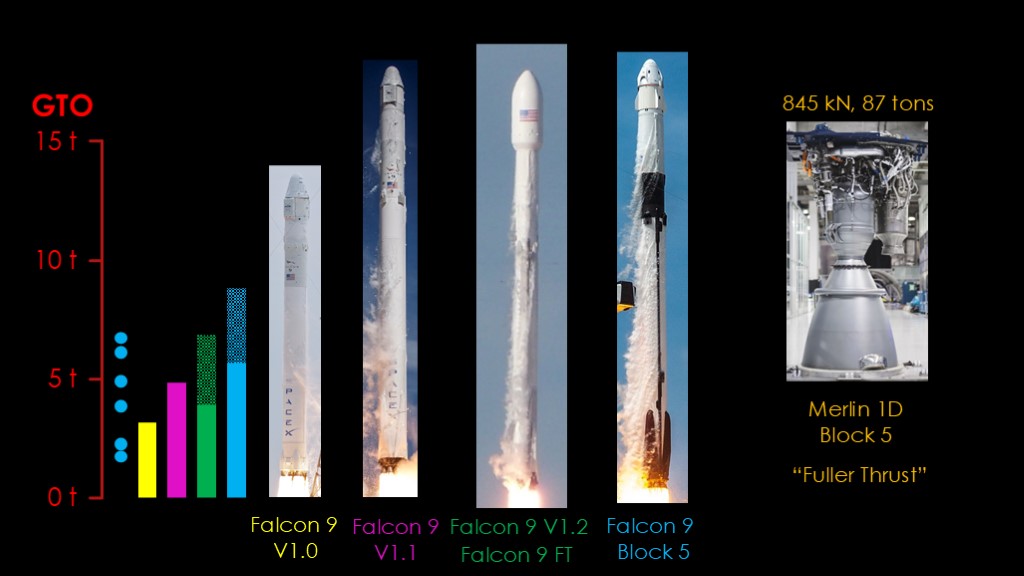
Which brings us to the final version of the Merlin, producing 845 kilonewtons or 87 tons, a little over double the thrust of the Merlin 1C, which is honestly an astounding increase in performance.
At this point SpaceX reveals that they have a different naming convention for their internal versions using "block" numbers to tell the revisions apart. This naming approach has a long history in aerospace dating back to Apollo and earlier.
This is the engine for block 5, so it's typically known as the Merlin 1D Block 5, though I have a fair bit affection for the "fuller thrust" label that is sometimes applied. The rocket is now the Falcon 9 block 5 that we are so familiar with. This final version pushes the reusable payload up to 5.5 tons and the expendable payload to 8.3 tons when flying to geosynchronous transfer orbit. That covers the vast majority of geosynchronous satellites.
While Plan A has been running - Falcon Heavy has been on the back burner, as it makes little sense doing a lot of engineering work when the rocket keeps changing underneath you. Plan A was hugely successful, getting rid of the main original justification for Falcon Heavy, but there are now some interesting other markets...
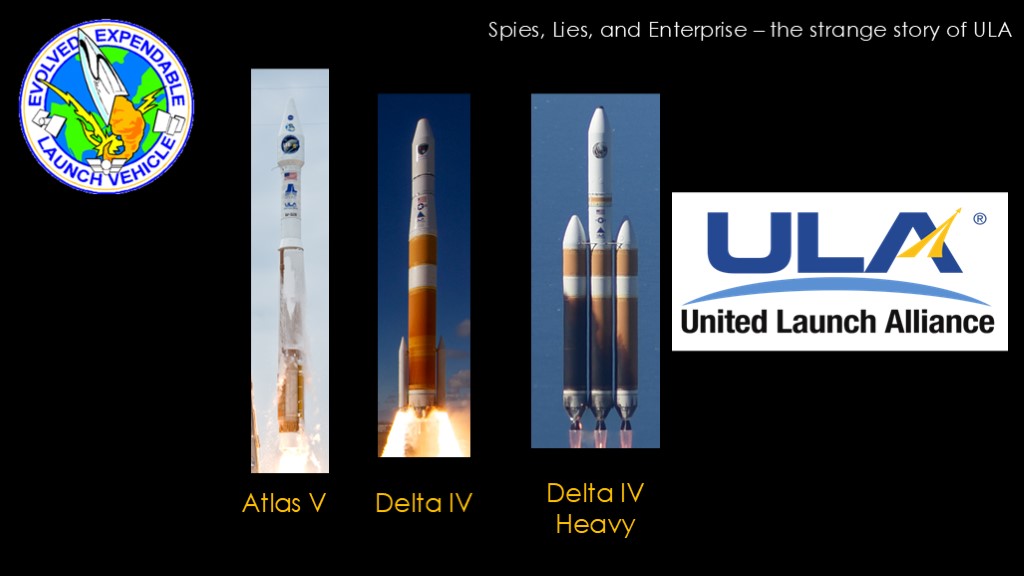
The evolved expendable launch vehicle program was created in 1994 to provide the US Department of Defense assured access to space for bigger payloads than could be launched by the Atlas II and Delta II vehicles. They also hoped to reduce the price of launches.
In 1988, the air force awarded contracts to Lockheed Martin for the Atlas V and McDonnell Douglas for the Delta IV. It turned into a very lucrative contract for both companies, and when they merged in 2006 to form United Launch Alliance, they had a monopoly on department of defense launches.
See "spies, lies, and enterprise - the strange story of ULA".
This situation led to ULA getting about $140 million for either an Atlas V or Delta IV launch and $430 million for a delta IV heavy. It was very profitable for ULA, and SpaceX wanted in on that business.
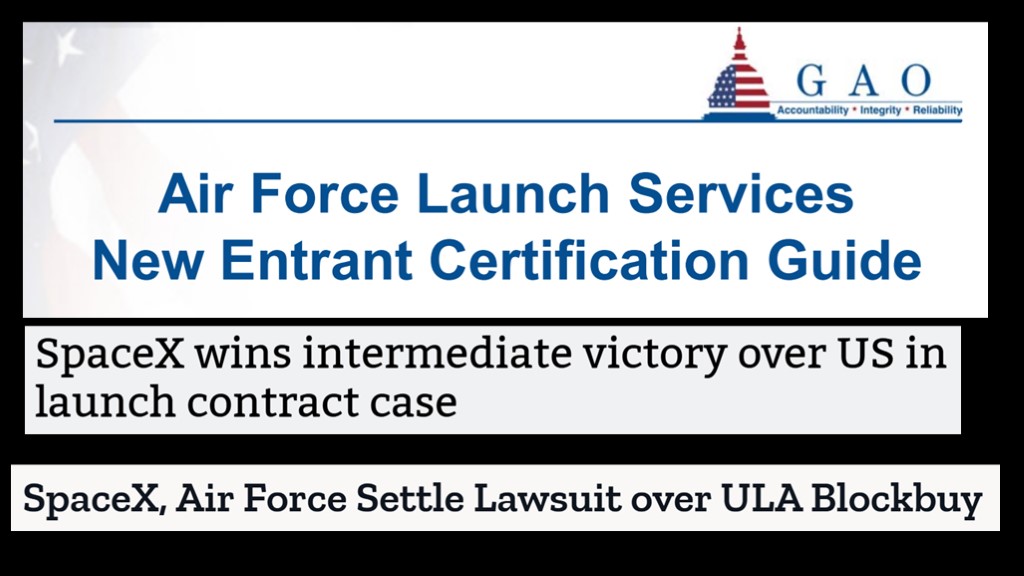
The first step was to get certified so they could be allowed to bid on those launches.
SpaceX felt that the Air Force was dragging its feet in certifying Falcon 9 and that the Air Force's plan to do a bulk buy of 36 rockets from ULA did not allow SpaceX to compete for the launches that Falcon 9 was capable of, and was therefore illegal under procurement laws.
SpaceX won an intermediate victory and the presiding judge sent the matter to mediation, and an agreement was reached in January 2015.
The big thing that SpaceX got out of this was a certification to launch Air Force payloads on Falcon 9, and a total of 7 launches in the phase 1 batch.

For the next set of launches - known as NSSL Phase 2 - the Air Force would be doing open bids and needed to come up with requirements for the launch companies. They decided that to be one of the two companies that did launches, you had to be able to launch all possible payloads.
Most of these can be covered by Falcon 9, either in reusable or expendable mode, but there's one glaring problem. The GEO 2 orbit requires putting 6,600 kilograms of payload all the way into geosynchronous orbit, and the Falcon 9 can only do about 3,000 kilograms. If you can't do that, you can't bid on this contract and therefore can't fly any of these payloads.
You can view this requirement in two ways...
The first is that it's designed to keep as much of the existing monopoly as possible up and running and the money going to ULA.
The second is that the Air Force is tired of paying $430 million for these launches and really wants SpaceX to build something so they can save that money.
I think it's probably a little bit of both.
The solution is obviously Falcon Heavy, and the air force was quick to certify Falcon Heavy after its first successful flight, thereby allowing SpaceX to get 40% of the launches. The remaining 60% of course went to ULA.
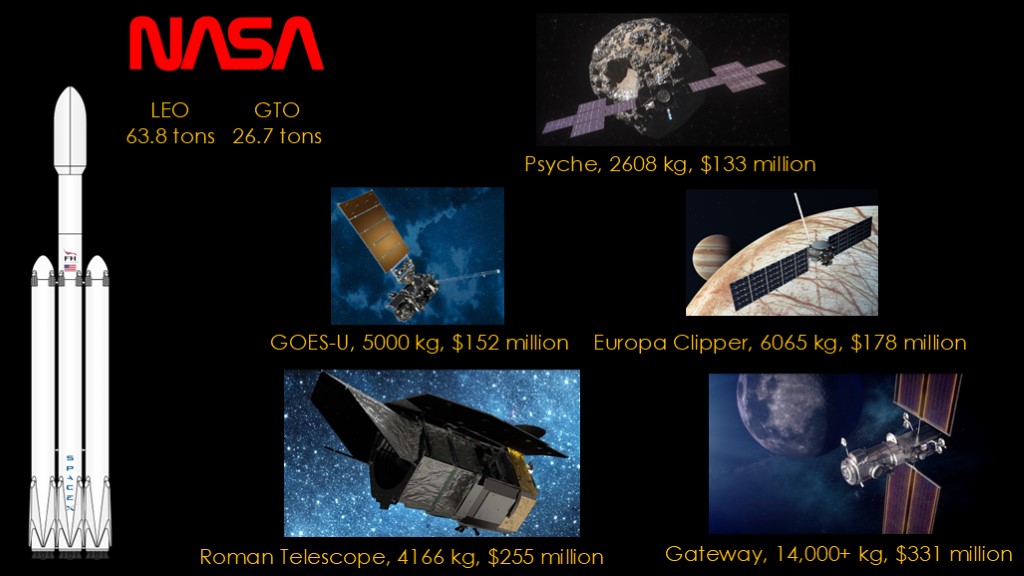
The other market was NASA, who were overjoyed to have access to such a big and cheap rocket, with a payload capacity of 63.8 tons to low earth orbit and 26.7 tons to geosynchronous transfer orbit. Those high payloads meant that Falcon Heavy had enough oomph to send the relatively light NASA probes on their high energy missions.
The Psyche mission to an asteroid was 2608 kg when launched in 2023, and NASA paid $133 for the launch.
NASA has 4 other missions scheduled to fly on Falcon Heavy.
The 5000 kg GOES-U weather satellite will fly to geostationary orbit in 2024 at a launch cost of $152 million.
Europa clipper will take a very long journey to arrive at Jupiter's moon Europa, and launching the 6065 kg satellite in late 2024 will cost NASA $178 million. Europa Clipper was originally designed to fly on NASA's SLS rocket which would have gotten the probe there faster, but lack of available SLS rockets and their $2 billion per launch price caused NASA to move to Falcon Heavy. This is a case where Falcon Heavy is a little small for the job.
Falcon Heavy will launch the 4166 kilogram Nancy Grace Roman Telescope to a halo orbit similar to the one the James Webb space telescope currently occupies in 2027, and NASA will pay $255 million for that mission.
And finally, Falcon Heavy will launch the first two modules of the lunar gateway space station into a weird elliptical orbit for $331 million. It will mass at least 14,000 kilograms, and it will put itself into the target Near Rectilinear Halo Orbit around the moon. This launch is currently scheduled for late 2025.
These NASA launches send just over $1 billion to SpaceX for 5 flights, though it's important to note that NASA requires extra services for their launches and therefore SpaceX does more work for those mission.
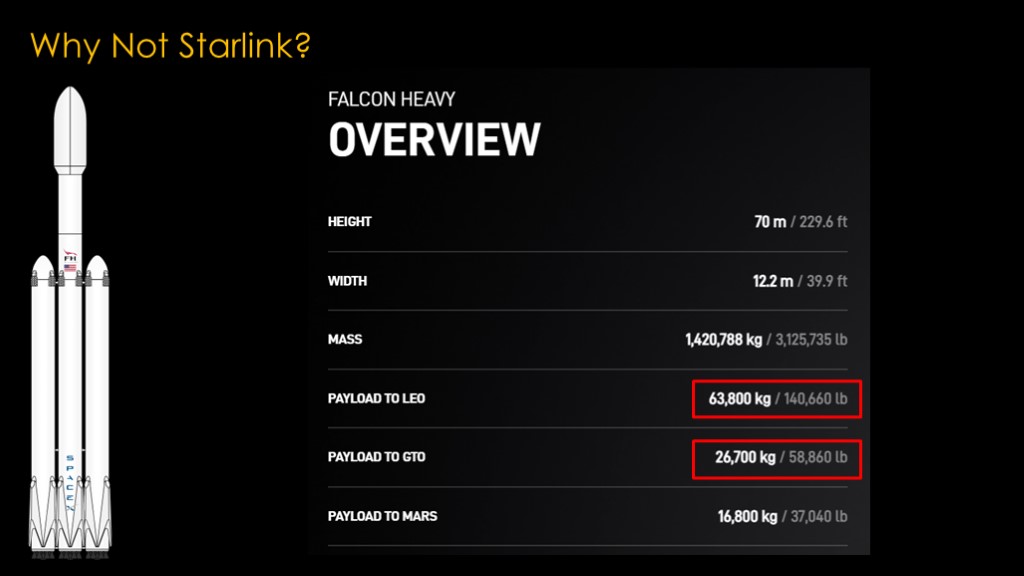
The Department of Defense and NASA both like Falcon Heavy, so why doesn't SpaceX use it Starlink? It would seem to be the perfect rocket for that mission.
It turns out that there are a few reasons why that isn't true...
If we look on SpaceX's Falcon Heavy page, we see this table, and it lists the Falcon Heavy payload to low earth orbit or geosynchronous transfer orbit. Those are big numbers.
Unfortunately, they aren't real, or at least they haven't been demonstrated...
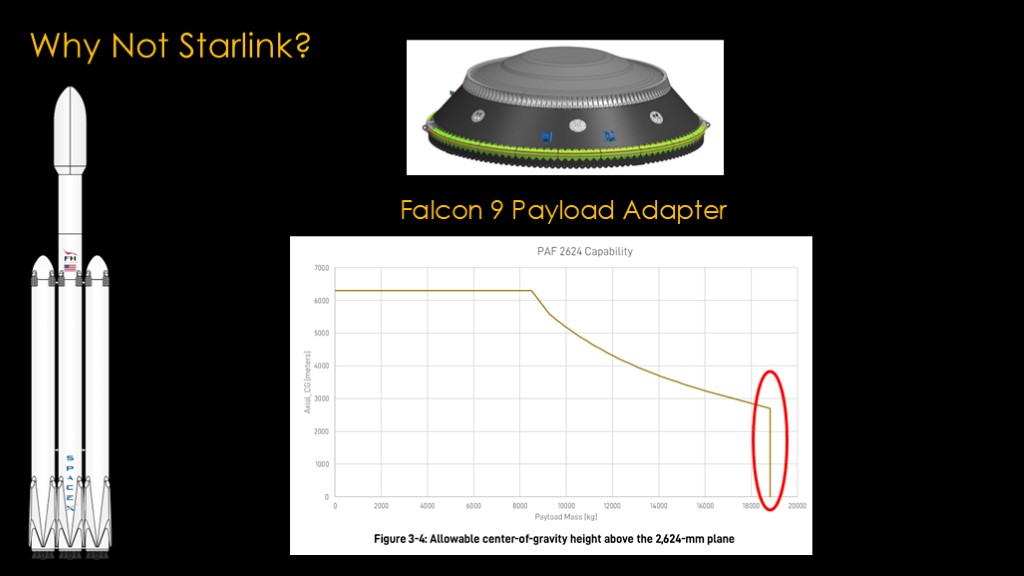
This is a Falcon 9 payload adapter, taken from the Falcon 9 User's Guide. The payload adapter is the interface between the rocket and the payload.
One of the things the user guide tells you is the center of gravity limitations of the adapter, and your payload will need to comply with these limitations or you might break something. Looking over at the right side of the graph, we see that there is a hard limit at 18,800 kilograms, which means the "standard" Falcon 9 cannot carry payloads greater than that amount.
You can ask SpaceX to do special work to carry more, but if you want to get to the GTO payload of 27 tons you are likely going to need strengthening elsewhere in the rocket and if you want to lift 64 tons to low earth orbit, you are definitely going to need a lot of extra work. So view both of those payloads as theoretical.
This doesn't matter for the department of defense or NASA because their goal is to take light payloads to hard-to-reach orbits rather than big payloads to easier orbits, though there are reports that NASA's gateway modules have hit this limit and that has caused some issues.
But this means that the standard Falcon Heavy couldn't carry many more Starlink satellites than Falcon 9 reusable can.
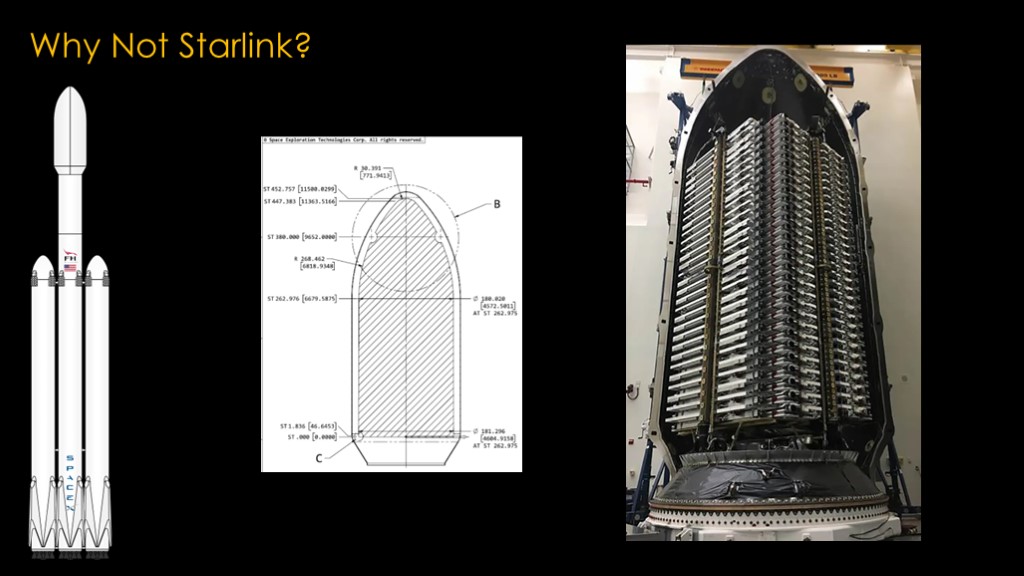
Even if Falcon 9 could carry more satellites, the current crop of satellites fill the Falcon 9 fairing to capacity - they are designed to fit together so they can fill the fairing. You could only fit a few more satellites in that fairing if you tried, and even the taller fairing under development for both NASA and the department of defense payloads could not carry enough satellites.

A third issue crops up related to reuse. SpaceX only has two autonomous drone ships available on the east coast, and that means they could only recover two of the cores. SpaceX has recently mentioned they are building a third drone ship for the east coast, but it's not currently available.
All these issues explain why Falcon Heavy does not fly starlink missions.
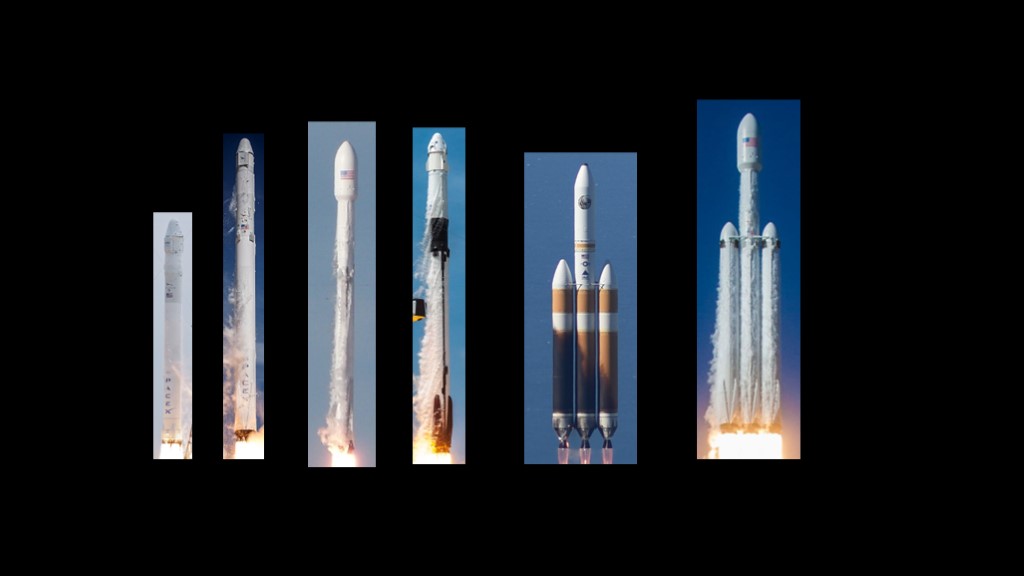
And that's the story of Falcon Heavy. Originally planned to make up for lack of performance on Falcon 9, then repurposed to launch difficult missions for the US government, and currently the worlds largest operational commercial rocket.

If you enjoyed this video, please send me this Gyrfalcon.
The Gyrfalcon is the world's heaviest true Falcon, though at 2 kilograms it is outmassed by the Falcon Heavy by a factor of 1 to 700,000 .